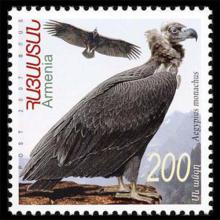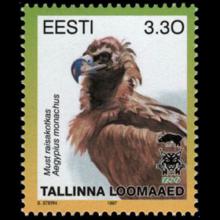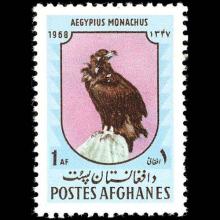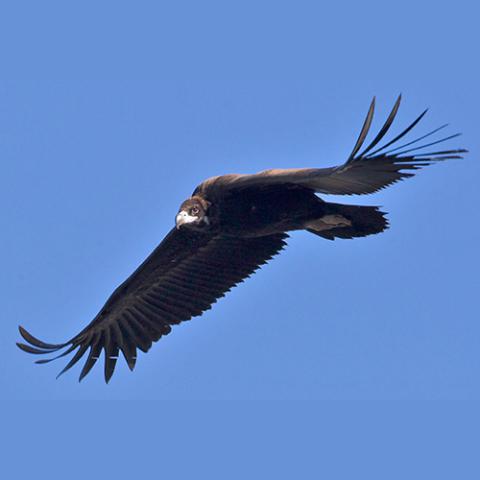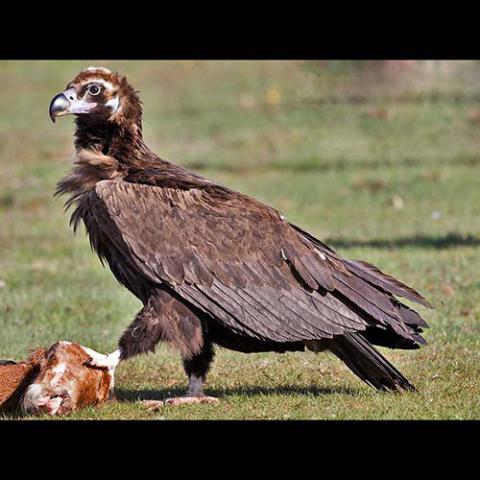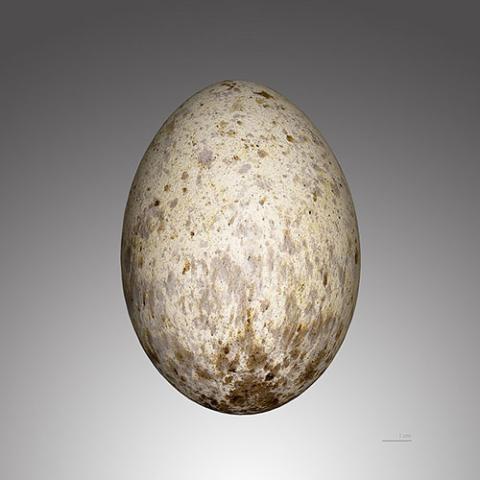NAMES
TAXONOMY
Armenia
Issued:
Stamp:
Aegypius monachus
Estonia
Issued:
Stamp:
Aegypius monachus
Afghanistan
Issued:
Stamp:
Aegypius monachus
Armenia
Issued:
Stamp:
Aegypius monachus
Estonia
Issued:
Stamp:
Aegypius monachus
Afghanistan
Issued:
Stamp:
Aegypius monachus
Armenia
Issued:
Stamp:
Aegypius monachus
Estonia
Issued:
Stamp:
Aegypius monachus
Afghanistan
Issued:
Stamp:
Aegypius monachus
Restoring Europe's Vultures
by Crispin Andrews, March 16, 2016
PHOTOS COURTESY OF VULTURE CONSERVATION FOUNDATION
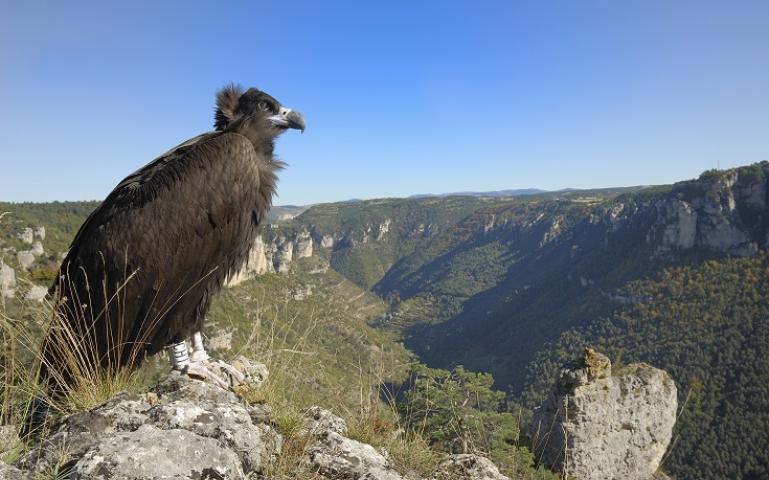
French farmers don’t like vultures. They’ve spent the last few years clamoring loudly about wolves, bears, and griffon vultures taking their livestock. Now, much to their dismay, conservationists from the Vulture Conservation Foundation (VCF) are releasing the world’s largest raptor, the Eurasian black vulture, into the French countryside. But while these birds might look big, mean, and ugly, they aren’t prone to nabbing small farm animals.
In fact, of Europe's four vultures—black, griffon, bearded, and Egyptian—only the Egyptian will occasionally snack on live prey, but it's just insects and worms, says VCF director Jose Tavares. Stories of griffon vultures carrying off lambs into the Alps are exactly that. Stories.
What is true: Over the last 25 years, humans have decimated vulture populations in Africa and Asia, mainly through poisoning, persecuting the birds, and destroying their habitat. Europeans also managed to nearly wipe out the birds in the late 19th and early 20th centuries. Now, with European Union legislation in place to ban offending poisons and cap overhunting of wild herbivores (the vulture’s preferred food source), the raptors are making a comeback in some regions.
“Vultures fulfill a very important ecological role—cleaning the countryside of carcasses that otherwise would breed disease,” Tavares explains. “After the collapse of vulture populations in India, rabies increased significantly because populations of feral dogs grew to feast on carcasses that otherwise would have been stripped clean by vultures.” Unlike those of feral dogs, rats, and other scavengers, a vulture’s stomach acid and immune system can deal with rabies and other pathogens quite well. Tavares says that the raptors also provide a significant service by picking up carcasses that otherwise would need to be taken to incineration by trucks, not only reducing carbon dioxide emissions but also saving taxpayer euros.
Tavares's next goal is to restore Europe’s vultures across the whole of their historical European range, from Spain in the west, across the Alps, the Balkan peninsula, and into Turkey. "Breeding sites across the whole range, with vultures moving between them, will help maintain genetic diversity and resilience," he says.
During the bad old days, the black vulture disappeared from Italy, the Balkans, and France, with only a few remaining in Andalucía. The same thing happened to the bearded vulture. Egyptian vultures and the more-common griffon vulture suffered similarly, but according to Tavares, the griffon’s varied diet and ability to forage for food enabled that bird to cope better with the challenging circumstances that all European vultures faced back then.
There are now 35 black vulture breeding pairs in France—in the Grands Causses, Verdon Gorge, and the Baronnies. "Black vultures are tree nesters, unlike other vultures, which are cliff nesters," Tavares says. "Ideally they need a forest, in a low mountainous area, with lots of old trees with flat tops, which they can nest in."
The VCF released three more black vultures into the Verdon Gorge last January. Tavares explains that the imported birds stay in aviaries for a few months, around other vultures, to get used to their new surroundings. "If we were to release new birds immediately, they would probably disperse, maybe back to Spain," he says. "You certainly wouldn’t get enough birds to establish a healthy new breeding population."
Griffon vultures are Europe’s most abundant, with most of them concentrated in Spain. Only Egyptian vulture numbers are still declining. Europe’s only migratory vulture, the Egyptian vulture, spends part of the year in Africa, where it is subject to the same dangers African vultures face, in particular poisoning. There’s also a long and dangerous migration across the Mediterranean Sea and Sahara Desert.
Tavares has his eye on southeastern Europe next. "In parts of the Balkans, unfortunately, some of the historical threats to vultures are still there," he says. "These countries joined the EU later and have been bound by the protective legislation for less time."
But griffon vultures are starting to recover in the Balkans, which is a hopeful sign. "Once we can be certain that the problems are starting to go away, we can begin to think about reintroducing the rarer vultures," he says.
The VCF aims to have black vultures in the Balkans by 2018 and bearded vultures soon after that. Its currently campaigning against poisoning in Bulgaria and working with locals to improve nesting sites and herbivore populations.
Reference: sieraclub.org
Genus species (Animalia): Aegypius monachus
The cinereous vulture (Aegypius monachus) is a large raptor in the family Accipitridae and distributed through much of temperate Eurasia. It is also known as the black vulture, monk vulture and Eurasian black vulture. With a body length of 1.2 m (3 ft 11 in), 3.1 m (10 ft) across the wings and a maximum weight of 14 kg (31 lb), it is among the largest Old World vultures.
Taxonomy
The genus name Aegypius is a Greek word (αἰγυπιός) for 'vulture', or a bird not unlike one; Aelian describes the aegypius as "halfway between a vulture (gyps) and an eagle". Some authorities think this a good description of a lammergeier; others do not. Aegypius is the eponym of the species, whatever it was in ancient Greek. The English name 'black vulture' refers to the plumage color, while 'monk vulture', a direct translation of its German name Mönchsgeier, refers to the bald head and ruff of neck feathers like a monk's cowl. 'Cinereous vulture' (Latin cineraceus, ash-colored; pale, whitish grey), was a deliberate attempt to rename it with a new name distinct from the American black vulture.
This bird is an Old World vulture, and as such is only distantly related to the New World vultures, which are in a separate family, Cathartidae, of the same order. It is, therefore, not closely related to the much smaller American black vulture (Coragyps atratus) despite the similar name and coloration.
Description
The cinereous vulture measures 98–120 cm (3 ft 3 in – 3 ft 11 in) in total length with a 2.5–3.1 m (8 ft 2 in – 10 ft 2 in) wingspan. Males can weigh from 6.3 to 11.5 kg (14 to 25 lb), whereas females can weigh from 7.5 to 14 kg (17 to 31 lb). It is thus one of the world's heaviest flying birds. Average weights are not known to have been published for this species but the median weight figures from two sources were 9.42 kg (20.8 lb) and 9.55 kg (21.1 lb). In Korea, a large survey of wild cinereous vultures was found to have weighed a mean of 9.6 kg (21 lb) with a mean total length of 113 cm (44 in), this standing as the only attempt to attain the average sizes of free-flying mature birds of the species, as opposed to nestlings or captive specimens. Unlike most accipitrids, males can broadly overlap in size with the females, although not uncommonly the females may be slightly heavier. These are one of the two largest extant Old World vultures and accipitrids, with similar total length and perhaps wingspans recorded in the Himalayan vulture (Gyps himalayensis), as indicated by broadly similar wing and tail proportions, but the cinereous appears to be slightly heavier as well as slightly larger in tarsus and bill length. Superficially similar but unrelated New World condors can either be of similar wing area and bulk or slightly larger in these aspects. Despite limited genetic variation in the species, body size increases from west to east based on standard measurements, with the birds from southwest Europe (Spain and south France) averaging about 10% smaller than the vultures from central Asia (Manchuria, Mongolia and northern China). Among standard measurements, the wing chord is 73–89 cm (29–35 in), the tail is 33–41 cm (13–16 in) and the tarsus is 12–14.6 cm (4.7–5.7 in).
The cinereous vulture is distinctly dark, with the whole body being brown excepting the pale head in adults, which is covered in fine blackish down. This down is absent in the closely related lappet-faced vulture (Torgos tracheliotos). The skin of the head and neck is bluish-gray and a paler whitish color above the eye. The adult has brown eyes, a purplish cere, a blue-gray bill and pale blue-gray legs. The primary quills are often actually black. From a distance, flying birds can easily appear all black. The immature plumage is sepia-brown above, with a much paler underside than in adults. Immature cinereous vultures have grey down on the head, a pale mauve cere and grey legs. The massive bill is one of the largest of any living accipiterid, a feature enhanced by the relatively small skull of the species. The exposed culmen of the cinereous vulture measures 8–9 cm (3.1–3.5 in). Only their cousin, the lappet-faced vulture, with a bill length of up to about 10 cm (3.9 in), can rival or outsize the bill of the cinereous. The wings, with serrated leading edges, are held straight or slightly arched in flight and are broad, sometimes referred to as "barn door wings". Their flight is slow and buoyant, with deep, heavy flaps when necessary. The combination of huge size and dark coloration renders the cinereous vulture relatively distinct, especially against smaller raptors such as eagles or buzzards. The most similar-shaped species, the lappet-faced vulture (with which there might be limited range overlap in the southern Middle East), is distinguished by its bare, pinkish head and contrasting plumage. On the lappet-face, the thighs and belly are whitish in adult birds against black to brownish over the remainder of the plumage. All potential Gyps vultures are distinguished by having paler, often streaky plumage, with bulging wing primaries giving them a less evenly broad-winged form. Cinereous vultures are generally very silent, with a few querulous mewing, roaring or guttural cries solely between adults and their offspring at the nest site.
Distribution and habitat
The cinereous vulture is an Eurasian species. The western limits of its range are in Spain and inland Portugal, with a reintroduced population in south France. They are found discontinuously to Greece, Turkey and throughout the central Middle East. Their range continues through Afghanistan eastwards to northern India to its eastern limits in central Asia, where they breed in northern Manchuria, Mongolia and Korea. Their range is fragmented especially throughout their European range. It is generally a permanent resident except in those parts of its range where hard winters cause limited altitudinal movement and for juveniles when they reach breeding maturity. In the eastern limits of its range, birds from the northernmost reaches may migrate down to southern Korea and China. A limited migration has also been reported in the Middle East but is not common.
This vulture is a bird of hilly, mountainous areas, especially favoring dry semi-open habitats such as meadows at high altitudes over much of the range. Nesting usually occurs near the tree line in the mountains. They are always associated with undisturbed, remote areas with limited human disturbance. They forage for carcasses over various kinds of terrain, including steppe, other grasslands, open woodlands, along riparian habitats or any kind or gradient of mountainous habitat. In their current European range and through the Caucasus and Middle East, cinereous vultures are found from 100 to 2,000 m (330 to 6,560 ft) in elevation, while in their Asian distribution, they are typically found at higher elevations. Two habitat types were found to be preferred by the species in China and Tibet. Some cinereous vultures in these areas live in mountainous forests and shrubland from 800 to 3,800 m (2,600 to 12,500 ft), while the others preferred arid or semi-arid alpine meadows and grasslands at 3,800 to 4,500 m (12,500 to 14,800 ft) in elevation. This species can fly at a very high altitude. One cinereous vulture was observed at an elevation of 6,970 m (22,870 ft) on Mount Everest. It has a specialized haemoglobin alphaD subunit of high oxygen affinity which makes it possible to take up oxygen efficiently despite the low partial pressure in the upper troposphere. Juvenile and immature cinereous vultures, especially those in the northern stretches of the species range, may move large distances across undeveloped open-dry habitats in response to snowfall or high summer temperatures.
Behavior
The cinereous vulture is a largely solitary bird, being found alone or in pairs much more frequently than most other Old World vultures. At large carcasses or feeding sites, small groups may congregate. Such groups can rarely include up to 12 to 20 vultures, with some older reports of up to 30 or 40.
Breeding
In Europe, the cinereous vulture return to the nesting ground in January or February. In Spain and Algeria, they start nesting in February in March, in Crimea in early March, in northwestern India in February or April, in northeastern India in January, and in Turkestan in January. They breed in loose colonies, with nests rarely being found in the same tree or rock formation, unlike other Old World vultures which often nest in tight-knit colonies. In Spain, nests have been found from 300 m (980 ft) to 2 km (6,600 ft) apart from each other. The cinereous vulture breeds in high mountains and large forests, nesting in trees or occasionally on cliff ledges. The breeding season lasts from February until September or October. The most common display consists of synchronous flight movements by pairs. However, flight play between pairs and juveniles is not unusual, with the large birds interlocking talons and spiraling down through the sky. The birds use sticks and twigs as building materials, and males and females cooperate in all matters of rearing the young. The huge nest is 1.45–2 m (4.8–6.6 ft) across and 1–3 m (3.3–9.8 ft) deep. The nest increases in size as a pair uses it repeatedly over the years and often comes to be decorated with dung and animal skins. The nests can range up to 1.5 to 12 m (4.9 to 39.4 ft) high in a large tree such as an oak, juniper, wild pear, almond or pine trees. Most nesting trees are found along cliffs. In a few cases, cinereous vultures have been recorded as nesting directly on cliffs. One cliff nest completely filled a ledge that was 3.63 m (11.9 ft) wide and 2.5 m (8.2 ft) in depth. The egg clutch typically only a single egg, though two may be exceptionally laid. The eggs have a white or pale buff base color are often overlaid with red, purplish or red-brown marks, being almost as spotted as the egg of a falcon. Eggs measure from 83.4 to 104 mm (3.28 to 4.09 in) in height and 58 to 75 mm (2.3 to 3.0 in) in width, with an average of 90 mm × 69.7 mm (3.54 in × 2.74 in). The incubation period can range from 50 to 62 days, averaging 50–56 days. Normally hatching occurs in April or May in Europe. The newly hatched young are semi-altricial. The young are covered in greyish-white to grey-brown colored down which becomes paler with age. The first flight feathers start growing from the same sockets as the down when the nestling is around 30 days old and completely cover the down by 60 days of age. The parents feed the young by regurgitation and an active nest reportedly becomes very foul and stinking. Weights of nestlings in Mongolia increased from as little as 2 kg (4.4 lb) when they are around a month old in early June to being slightly more massive than their parents at up to nearly 16 kg (35 lb) shortly before fledging in early autumn. Fledging is reported when the nestlings are 104–120 days old, though dependence on parents can continue for another two months. Radio-satellite tracking suggests the age of independence of juveniles from their parents to be 5.7–7 months after hatching (i.e. 2–3 months after fledging).
The nesting success of cinereous vultures is relatively high, with around 90% of eggs successfully hatching and more than half of yearling birds known to survive to adulthood. They are devoted, active parents, with both members of a breeding pair protecting the nest and feeding the young in shifts via regurgitation. In Mongolia, Pallas's cat (Otocolobus manul) and the common raven (Corvus corax) are considered potential predators of eggs in potentially both tree and cliff nests. Gray wolves (Canis lupus) and foxes are also mentioned as potential nest predators, but since neither one can climb trees and there are also no incidents of predation on inaccessible cliff nests, this seems unlikely. There have been witnessed accounts of bearded vultures (Gypaetus barbatus) and Spanish imperial eagles (Aquila adalberti) attempting to kill nestlings, but in both cases they were chased off by the parents. There is a single case of a Spanish imperial eagle attacking and killing a cinereous vulture in an act of defense of its own nest in Spain. Golden eagles and Eurasian eagle-owls may rarely attempt to dispatch an older nestling or even adults in an ambush, but the species is not verified prey for either and it would be a rare event in all likelihood if it does occur. This species may live for up to 39 years, though 20 years or less is probably more common, with no regular predators of adults other than man.
Feeding
Like all vultures, the cinereous vulture eats mostly carrion. The cinereous vulture feeds on carrion of almost any type, from the largest mammals available to fish and reptiles. In Tibet, commonly eaten carcasses can include both wild and domestic yaks (Bos mutus and Bos grunniens), Bharal, Tibetan gazelles (Pseudois nayaur), kiangs (Equus kiang), woolly hares (Lepus oiostolus), Himalayan marmots (Marmota himalayana), domestic sheep (Ovis aries), and even humans, mainly those at their celestial burial grounds. Reportedly in Mongolia, Tarbagan marmots (Marmota sibirica) comprised the largest part of the diet, although that species is now endangered as it is preferred in the diet of local people, wild prey ranging from corsac fox (Vulpes corsac) to Argali (Ovis ammon) may be eaten additionally in Mongolia. Historically, cinereous vultures in the Iberian Peninsula fed mostly on European rabbit (Oryctolagus cuniculus) carcasses, but since viral hemorrhagic pneumonia (VHP) devastated the once abundant rabbit population there, the vultures now rely on the carrion of domestic sheep, supplemented by pigs (Sus scrofa domesticus) and deer. In Turkey, the dietary preferences were argali (Ovis ammon) (92 carrion items), wild boar (Sus scrofa) (53 items), chickens (Gallus gallus domesticus) (27 items), gray wolves (13 items) and red foxes (Vulpes vulpes) (13 items). Unusually, a large amount of plant material was found in pellets from Turkey, especially pine cones. Among the vultures in its range, the cinereous is best equipped to tear open tough carcass skins thanks to its powerful bill. It can even break apart bones, such as ribs, to access the flesh of large animals. It is dominant over other scavengers in its range, even over other large vultures such as Gyps vultures, bearded vultures or fierce ground predators such as foxes. While the noisy Gyps vultures squawk and fly around, the often silent cinereous vultures will keep them well at bay until they are satisfied and have had their own fill. A series of photos taken recently show a cinereous vulture attacking a Himalayan griffon in flight for unknown reasons, although the griffon was not seriously injured. Cinereous vultures frequently bully and dominate steppe eagles (Aquila nipalensis) when the two species are attracted to the same prey and carrion while wintering in Asia. A rare successful act of kleptoparasitism on a cinereous vulture was filmed in Korea when a Steller's sea eagle (Haliaeetus pelagicus) stole food from the vulture.
Its closest living relative is probably the lappet-faced vulture, which takes live prey on occasion. Occasionally, the cinereous vulture has been recorded as preying on live prey as well. Live animals reportedly taken by cinereous vultures include calves of yaks and domestic cattle (Bos primigenius taurus), piglets, domestic lambs and puppies (Canis lupus familiaris), foxes, lambs of wild sheep, together with nestling and fledglings of large birds such as geese, swans and pheasants, various rodents and rarely amphibians and reptiles. This species has hunted tortoises (which the vultures are likely to kill by carrying in flight and dropping on rocks to penetrate the shell; cf. Aeschylus#Death) and lizards. Although rarely observed in the act of killing ungulates, cinereous vultures have been recorded as flying low around herds and feeding on recently killed wild ungulates they are believed to have killed. Mainly neonatal lambs or calves are hunted, especially sickly ones. Although not normally thought to be a threat to healthy domestic lambs, rare predation on apparently healthy lambs has been confirmed. Species believed to be hunted by cinereous vultures have included argali, saiga antelope (Saiga tatarica), Mongolian gazelle (Procapra gutturosa) and Tibetan antelope (Pantholops hodgsonii).
Reference: Wikipedia, allaboutbirds.org
Photos: Juan Lacruz - Own work, CC BY-SA 3.0, Didier Descouens - Own work, CC BY-SA 4.0

